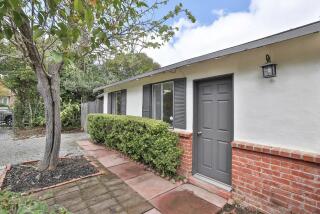Getting Smart About Art of Living Small
- Share via
After decades of ever-rising square footage in the McMansions that dot the suburbs, the idea of downsizing is gaining champions.
The size of the average new single-family home has gone from 1,520 square feet in 1971 to 2,120 square feet in 1996, according to “1998 Housing Facts, Figures and Trends,” published by the National Assn. of Home Builders.
The median price of a typical new home has almost tripled from $48,800 in 1977 to $144,500 in 1997, according to the NAHB. And more expensive houses usually are considerably bigger than the average.
“But not everyone is living in a McMansion or aspires to it,” said Gale Steves, editor of Home Magazine. “Every time we do a small house in the magazine, there is lots of mail.”
A new book, “Home Magazine’s Best Little Houses” (Friedman/Fairfax, $25) with an introduction by Steves, focuses on about 20 houses--with less than 2,000 square feet--that were featured in the magazine over the past four years.
Other books focusing on the pleasures of living in smaller spaces include Karl Ashley Smith’s “The Haiku Cottage: Designing the Eloquent Small Home” (Futura Bold, $12) and Jim Tolpin’s “The New Cottage Home” (The Taunton Press $29.95).
Due out Oct. 15 is “The Not So Big House: A Blueprint for the Way We Really Live” (Taunton $30) by Sarah Susanka.
All the books share a common point of view: namely that big rooms and lots of them have little to do with real comfort.
Beyond books, some builders are beginning to offer smaller houses as part of the trend toward traditional neighborhood design.
“Architects and designers are very interested in the challenge of the small house,” said Susan Bradford Barror, editor of Residential Architect.
The magazine, read by architects and others in the home-building field, is sponsoring a design contest for a 1,200-square-foot house. The winning design will be built in Westchester County, N.Y. A family selected by the Westchester chapter of Habitat for Humanity will reside in the house. A portion of the construction will be shown on the “CBS This Morning” program during a week in November, Barror said.
Susanka’s architectural firm, Mulfinger Susanka Mahady & Partners of Minneapolis, has been chosen to design Life magazine’s 1999 dream house, to be shown in the magazine next May. The house will reflect the precepts of her forthcoming book.
The traditional market for small houses is first-time buyers on a budget, empty nesters and working couples with no children. Increasingly however, families with children may begin to seek smaller spaces.
“It is too expensive and takes too much work to furnish and maintain a large house,” said Smith, an architect in Santa Rosa, Calif. “Small houses, like Japanese haiku poems, accomplish a great deal with little,” Smith’s 1997 book offers seven examples of small homes. The smallest is 260 square feet for one person; the largest has three bedrooms and a playroom and is just more than 1,000 square feet.
“A small house forces you to make good choices,” added Smith, who lives with his wife and three children in a 1920s bungalow. “I can’t think of any furniture or any room that we don’t use every day.”
Thinking flexibly is a key to living happily in a small house.
“Do you really need a separate dining room if you use it only two or three times a year?” Steves asked rhetorically. “Maybe you need a kitchen with space for everyday dining, and you bring a table into the living room a few times a year.”
She said the bottom line is that “many little houses actually have more usable space than a big house. And it is cozy space with nooks and crannies and charm and a human scale. It can be frightening to be in a room with a 15-foot ceiling.”
More to Read
Sign up for our Book Club newsletter
Get the latest news, events and more from the Los Angeles Times Book Club, and help us get L.A. reading and talking.
You may occasionally receive promotional content from the Los Angeles Times.










